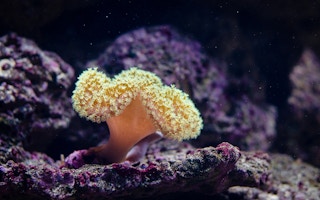In an attempt at window dressing to cover up the slow, painful death of the Great Barrier Reef due to ocean warming, the government earmarked A$500 million (US$379 million) to ‘protect’ it, as reported in a recent article on Eco-Business.
To continue reading, subscribe to Eco‑Business.
There's something for everyone. We offer a range of subscription plans.
- Access our stories and receive our Insights Weekly newsletter with the free EB Member plan.
- Unlock unlimited access to our content and archive with EB Circle.
- Publish your content with EB Premium.
This money is a sham. It does nothing to address climate change, the biggest threat to the reef.
Worse still, some A$444 million of this slush fund goes to The Great Barrier Reef Foundation, a foundation with climate-denial links whose patrons make the largest donations to the ruling Liberal National Party coalition and fossil fuel operators, including Mitsubishi, Rio Tinto, BHP, Origin Energy, AGL and ConocoPhillips Australia.
All of this is bad enough - but to add insult to injury, the foundation has coal group Peabody Energy (which has funded anti-climate activism around the world) on its Chairman’s Panel. Former chief executive of Esso John Schubert, with links to fossil fuel operators, including Mitsubishi, Rio Tinto, BHP, Origin Energy, AGL and ConocoPhillips Australia, is chairing the panel.
Making big promises to save the reef is part of Australia’s budget, launched every May. This year it was all about tax cuts and ignores climate change altogether. This is particularly astounding because the majority of Australians—polls say 77 per cent—want our government to act on climate and as much as 96 per cent support the move to clean energy. It is nothing more than fossil fuel lobbying holding prime minister Malcolm Turnbull to ransom and preventing Australia from getting on with it.
Overall the budget almost halves climate spending to $1.6 billion, dropping further to $1.2 billion by 2020. Funding for the Department of Environment and Energy has again been slashed, and is now slated to plunge by 43 per cent of 2013 levels by 2022. The budget will see $30 billion poured into diesel tax subsidies to private companies over the forecast period, but no additional money for renewables or climate mitigation and adaptation will be forthcoming.
The government continues to throw billions of our taxpayer dollars into fossil fuel subsidies while stripping money from effective climate initiatives and scrapping Australia’s renewable energy target, leaving billions of dollars of investment into solar and wind high and dry. Despite the government’s lack of support, future-thinking innovators are leading Australia forward to a clean energy future. Even Australia’s largest carbon polluter, power company AGL, is investing more than $2 billion in renewables and storage (although the company continues to push new gas as well). The community of Port Augusta bravely campaigned to replace its old coal-fired power station with solar thermal generation.
But voters shouldn’t be swayed by the flash of cash. If we are to protect our environment from dangerous climate change, the next election must be about which candidates are going to reduce emissions and transition to a 100 per cent renewable energy economy.
In response, the Australian Labor Party has seized upon the Government’s inaction and has pledged to take major action on climate – including a 50 per cent renewable energy target and initiatives to boost the uptake of community energy.
Yet the ALP still fails to distinguish itself from the Coalition when it comes to the proposed Adani Carmichael mega coal mine. Although the government is eager to support the mine, leader of the ALP Bill Shorten has refused to give a clear policy position on how his party would handle the mine. He commented that if it didn’t stack up “environmentally and economically”, it would not go ahead.
With five federal by-elections pending in coming months, pundits have decreed these polls will be a referendum on which party has the better tax policy, although there is much more on the line. At stake are the futures that Australia’s two political parties envision.
One vision is that of a government with its head in the sand and its feet tied by the fossil fuel industry, ignoring the transition that is already happening around the world and in the business sector right here in Australia. The other is of a government that acknowledges the important transition we are already going through and promotes clean technology and provides employment opportunities for those in the coal industry.
This vision is one where the vibrant biodiversity of the Great Barrier Reef is treasured and preserved through long-lasting, meaningful policies to shift us away from polluting fossil fuels and into a future of renewable energy.
Blair Palese is the co-founder and chief executive of 350.org Australia











